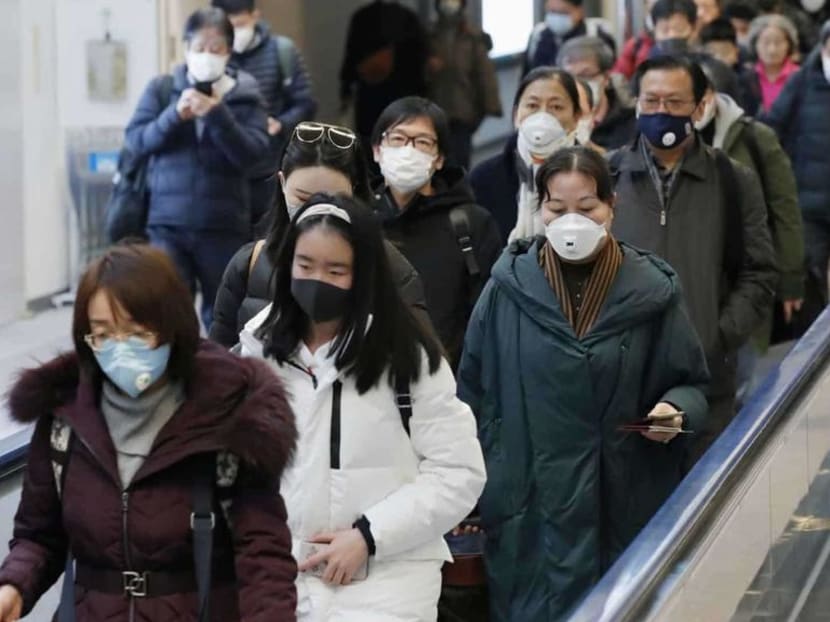Explainer: What WHO’s declaration of Wuhan coronavirus as a global emergency means for the man in the street
SINGAPORE — The World Health Organization (WHO) on Thursday (Jan 30) declared the Wuhan coronavirus epidemic in China a public health emergency of international concern (PHEIC).

Passengers arriving from the Chinese city of Wuhan arrive at Narita Airport in Chiba, Japan in this photo taken by Kyodo on Jan 23, 2020.
SINGAPORE — The World Health Organization (WHO) on Thursday (Jan 30) declared the Wuhan coronavirus epidemic in China a public health emergency of international concern (PHEIC).
The virus, which first originated in Wuhan, China has claimed more than 200 lives so far and spread to 20 countries and territories.
The decision was announced by WHO director-general Tedros Adhanom Ghebreyesus after a meeting with the organisation’s emergency committee, an advisory body of international experts.
Previously, five other global epidemics have been declared public health emergencies by the WHO. They are:
The H1N1 swine flu epidemic in 2009
The polio virus outbreak in 2014
The Zika emergency in 2016
The West African Ebola epidemic in 2014 and in 2019
TODAY takes a closer at look at how the WHO decides whether a public health crisis should be declared a global emergency and how the decision will affect the global fight against the spread of the Wuhan coronavirus.
WHY DECLARE A GLOBAL EMERGENCY NOW?
The WHO first introduced the concept of the PHEIC in 2005, after the Sars virus outbreak in 2003.
According to the WHO, a PHEIC is declared when there is an “extraordinary event which is determined… to constitute a public health risk to other states through the international spread of disease”.
The declaration would give the WHO the capabilities to help facilitate the containment of the virus globally as it bestows the organisation certain capabilities to ramp up the response of governments and organisations globally that are rushing to contain an outbreak.
For example, it would allow the WHO to put travel advisories in place for certain cities, regions and countries. It would also give the organisation the ability to review public health measures carried out by various countries to ensure that they are up to proper health standards.
“These are non-binding but practically and politically significant measures that can address travel, trade, quarantine, screening, treatment. WHO can also set global standards of practice,” said the WHO on Twitter on Friday.
Declaring an epidemic a global health emergency under the PHEIC will also send a message to the world that the outbreak is a public health emergency that should be taken seriously
Though the WHO does not have legal authority to sanction countries, the PHEIC declaration gives the organisation the ability to put pressure on member states to abide by its advisories as they are bound by the 2005 International Health Regulations.
HOW DOES THE DECLARATION AFFECT TRAVELLERS?
Travellers who have recently bought travel insurance for their upcoming trips abroad should take note as their claims may be affected, depending on when they purchased their policy, as different insurance companies have indicated different cut-off dates for claims in response to the Wuhan coronavirus outbreak.
Insurance agencies that TODAY spoke to said that even before the WHO’s announcement, travel insurance claims were already affected by the various travel advisories that have been announced by the authorities.
A spokesperson for AXA Insurance said: “In view of MOH’s advisory to defer non-essential travel to mainland China, our travel insurance does not cover any claims arising from the outbreak, which is deemed a ‘known’ event, for trips to or passing through the country.”
The spokesperson added that AXA will process claims and trip cancellation requests arising from the coronavirus outbreak if the customer departed Singapore for Wuhan before Jan 11 and mainland China before Jan 27.
Meanwhile, a Great Eastern spokesperson said that it would honour claims arising from the Wuhan virus if the policy or trip was purchased before 9.30am on Jan 24.
However, it will not provide coverage for travel to, from and through Hubei province and mainland China if the travel policy was purchased after 9.30am on Jan 24 and 11.59pm on Jan 28 respectively.
Likewise, a FWD spokesperson said that it will not cover any claims related to the outbreak for travels in, to, or through mainland China if the policy was bought on or after Jan 23.
FWD will also not entertain trip cancellation, postponement or disruption claim requests if the travel policy was bought on or after Jan 31.
HOW DOES THE DECLARATION AFFECT SINGAPORE?
During a press conference on Friday, National Development Minister Lawrence Wong said that the Government’s decision to ramp up measures against the Wuhan coronavirus was not solely based on the WHO’s announcement.
The authorities had announced that from 11.59pm on Saturday, all new visitors who have been to China in the last 14 days will be barred from entering and transiting through Singapore.
With immediate effect, the Immigration and Checkpoints Authority will also stop issuing all forms of new visas to those with People’s Republic of China passports.
Mr Wong said: “The measures that we have just announced did not just come about because of the WHO announcement. As I mentioned before, we have a series of drawer plans and we look at each action based on the latest information and expert advice.”
Separately, Associate Professor Kenneth Mak, deputy director of medical services at the Health Ministry, said that the MOH’s Disease Outbreak Response System Condition (DORSCON) is used to reflect the degree of risk for infection to spread among people in Singapore.
Because there is currently no evidence of community spread of the virus here, the DORSCON level will remain at yellow, Assoc Prof Mak said.
There are currently 16 confirmed cases of the novel coronavirus in Singapore and except for one Singaporean, the rest of the infected patients are Chinese nationals from Wuhan.








